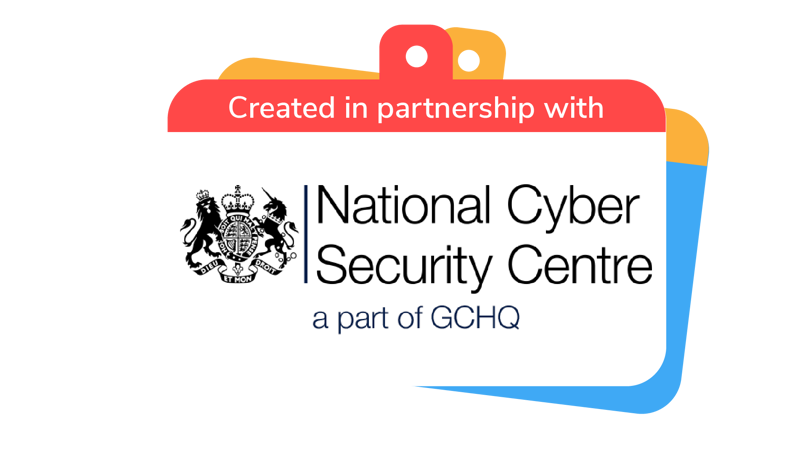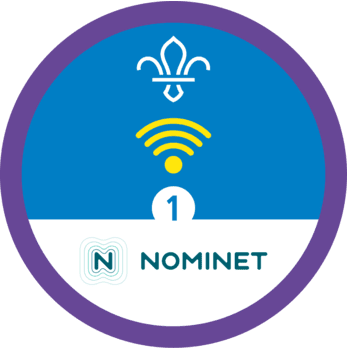
Play data backers
You’ll need
- Blindfolds (one per team)
- Small objects to represent ‘data’ (such as beanbags)
- Obstacles (such as light cardboard boxes, plastic cups or foam footballs)
- Buckets or boxes
- A stopwatch or timer
- Masking tape, chalk or rope to mark the start line
Before you begin
- Use the safety checklist to help you plan and risk assess your activity. There's also more guidance to help you carry out your risk assessment, including examples.
- Make sure all young people and adults involved in the activity know how to take part safely.
- Make sure you’ll have enough adult helpers. You may need some parents and carers to help.
Planning and setting up this activity
- If unsure about cyber security knowledge, you can use the National Cyber Security Centre (NCSC) resources and improve your skills before running the activity.
- Mark out a start line at one side of the space. If you’ve got lots of people, you may want to have start lines at different, but equal, places around the space, such as at both sides of the room.
- Spread out the objects, such as beanbags, across the room. These objects will be your ‘data’.
- To make the game trickier, make sure that there’s more ‘data’ items further away from the start line, than closer to it.
- Set up safe, secure obstacles between the start line and the ‘data’ objects. Make sure that they’re safe and won’t become a trip hazard, as people will be blindfolded while playing the game. Some examples could be foam footballs or light cardboard boxes.
- Make sure there’s a bucket, or something similar, for each team. This’ll represent their ‘backup storage’
- Use a strong and different password for your email: Combining 3 random words that each mean something to you is a great way to create a password that is easy to remember but hard to crack. You should use a different password for each of your accounts, particularly your email account.
- Consider using a Password Manager: A password manager can store all your passwords securely, so you don’t have to worry about remembering them, helping you to use strong, separate passwords for all your important accounts.
- Enable Two-Step Verification (2SV): Aim to use Two-Step Verification (2SV) wherever possible. This can involve entering a code that’s sent to your phone or email, as well as your password. It’s often also known as Two-Factor Authentication or Multi-Factor Authentication (MFA).
- Keep software regularly updated: Regularly update your operating system, apps and antivirus software to protect against the latest threats. Cybercriminals, often known as hackers, make use of and benefit from weaknesses in outdated software to steal information.
- Look out for phishing and scams: For emails, messages or texts, always avoid using suspicious links or downloading attachments from unknown sources. Phishing emails, messages and texts often look legitimate, but their aim is to steal your information. They often use suspicious URL’s or email addresses, use bad spelling and have bad formatting.
- Back up data regularly: Always back up your most important files stored in a secure location, such as on an external hard drive or in cloud storage. This helps to protect you from data loss if there’s malicious software (such as viruses, worms, spyware) or hardware failures.
- Educate others: Make sure you stay informed about the latest cybersecurity threats and how to protect yourselves from them. It's always good to tell your friends, family and loved ones about them too.
Running this activity
- Gather everyone together and ask everyone if they’ve heard of cyber security. You could see if anyone knows what it is and why’s it important. Explain that cyber security is how you can reduce the risk of cyber-attack. Cyber security helps to protect the devices we all use, such as smartphones, laptops, tablets, computers, and online services, from theft or damage.
- Ask if anyone knows what backup is. A backup is a copy of your important data that's stored in a separate safe location, usually on the internet (known as cloud storage), or on removable media (such as USB stick, SD card, or external hard drive). They help us to protect against human errors, hardware failures, viruses, cyber-attacks, power failures and more. Backups can help save time and money if these failures occur
- Tell everyone that this activity is all about learning about backing up our data. Ask everyone what they might want to have a backup copy of and why.
- Explain that you’re going to play a game and ask everyone to get into teams.
- Each team will choose someone who will be blindfolded. The blindfolded person will represent someone trying to back up important data from their laptop.
- The whole team will be behind the line. Anyone who is not blindfolded will need to always stay behind the line.
- The items around the room represent the data, which the blindfolded person will need to try to collect. The obstacles spread around the room represent risks and challenges that can cause data loss. Teams will guide their blindfolded teammate to collect data and bring it back to the backup storage. Adults and young leaders should make sure to supervise the blindfolded participants closely to prevent accidents.
- The goal is to collect as much data as possible and bring it to the ‘backup storage’, but without bumping into obstacles or other people.
- If the blindfolded person bumps into an obstacle or another person, they must drop any data they were carrying and return to the start line.
- The team members can use only verbal instructions to guide their teammate, such as ‘Take three steps forward’ or ‘Turn left’ and so on.
- You can play this game in rounds, with each round lasting five minutes. This gives everyone who wants to be blindfolded the chance to.
- At the end of each round, count and note down the number of data objects in each team's backup storage bucket.
- The team with the most data in their bucket at the end of all the rounds, wins.
Let us know how it went:
Our supporter, the National Cyber Security Centre (NCSC), is keen to know how much you have learned about cyber security. If you’re happy to take part in their review, please ask your group these questions and send their answers to the NCSC using our Microsoft form.
You’re going to read out a set of statements and everyone must decide if they Agree, Disagree or are Unsure. You could do this in lots of ways. You could use a thumbs up, thumbs down and thumbs in the middle. You could go round in a circle and ask people to say their answer, or you could set up three labelled areas for people to move between to show their answer. You will then report what the majority of the group answered.
You may wish to run this before and after the activity to see what people have learned during the session.
Reflection
This activity was all about working as a team and learning about cyber. What did you learn about backing up your data? Does anyone know if they have a backup of their data? Is anyone now wanting to back up their data? What would you tell someone else about backing up data?
In this game, we pretended to back up our data. Why’s it important and what happens if you don't back up your data? Backing up your data is essential to prevent loss from accidental deletion, hardware failure or cyber threats. It ensures you can recover important files, giving you peace of mind that your data is safe.
You also had to work as a team. How did you help the person who was blindfolded to reach the data? How did you make sure your instructions were clear? Were there any techniques you used? Did one person speak or did lots of people try to give instructions? If you were blindfolded, were your team’s instructions easy to follow?
Safety
All activities must be safely managed. You must complete a thorough risk assessment and take appropriate steps to reduce risk. Use the safety checklist to help you plan and risk assess your activity. Always get approval for the activity, and have suitable supervision and an InTouch process.
- Active games
The game area should be free of hazards. Explain the rules of the game clearly and have a clear way to communicate that the game must stop when needed. Take a look at our guidance on running active games safely.
- To make this activity easier, you could let one team go at a time, so the person that’s blindfolded can hear directions more clearly.
- To make this activity harder, you could introduce time penalties for bumping into obstacles or restrict the amount of data a blindfolded person can carry at once.
- To make this activity harder, you could also add in someone who is the cyber-attacker, who tries to steal someone’s data before they can back it up. This could be an adult, young leader or a young person. For example, you may have a rule where they can tap someone on the shoulder and steal someone’s data, then the person has to drop it and return to the start. They hacker then needs to return to tap a certain point in the space, such as a door, or sit on a chair before stealing again.
Make sure the space is designed so that everyone can move around and access the data to collect
All Scout activities should be inclusive and accessible.
If you enjoyed this activity, check out our others on cyber security or encourage the young people to check out the fun resources from the National Cyber Security Centre such as Cyber Sprinters - the award-winning interactive online security resources for 7-11 year olds. Or Cyber Navigators - all about how to stay secure online, it's an interactive online security resources for 11–14 year olds.
